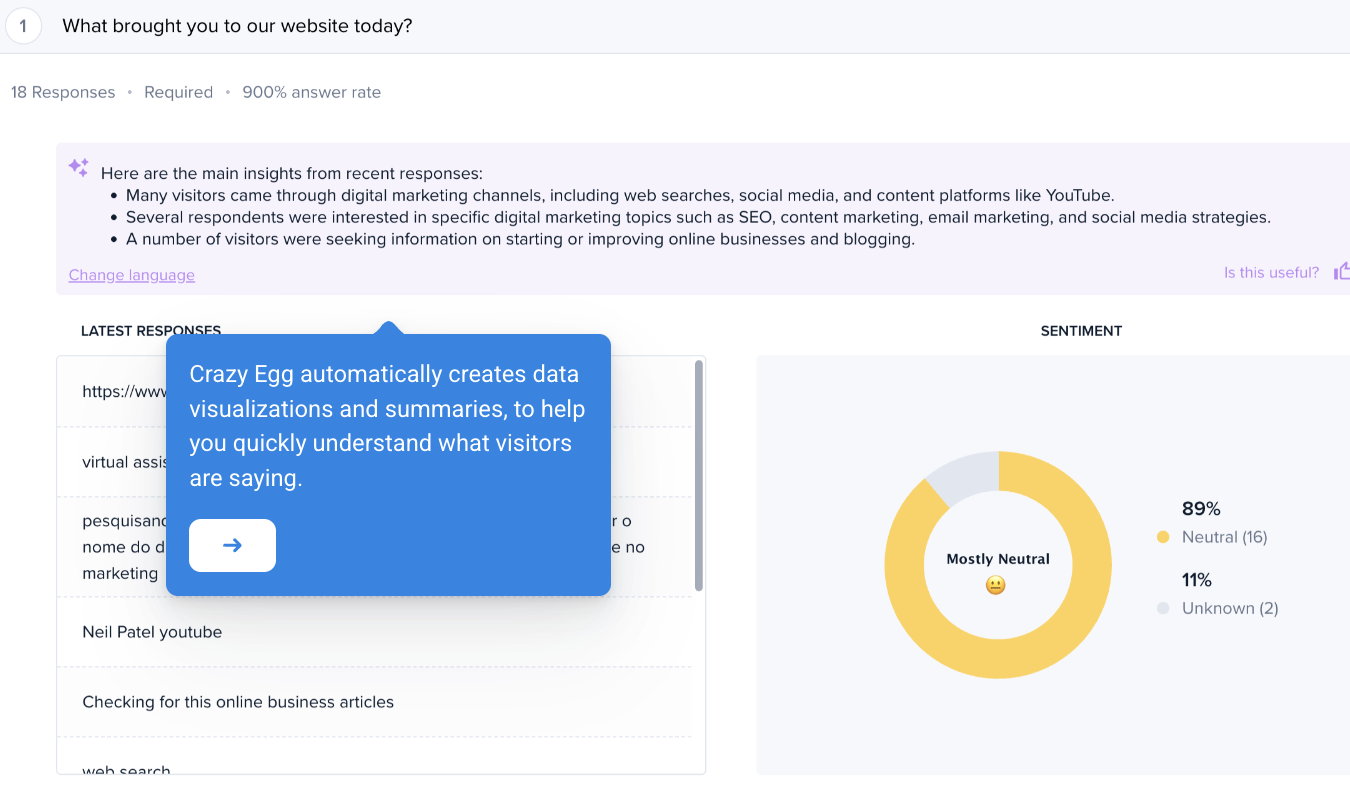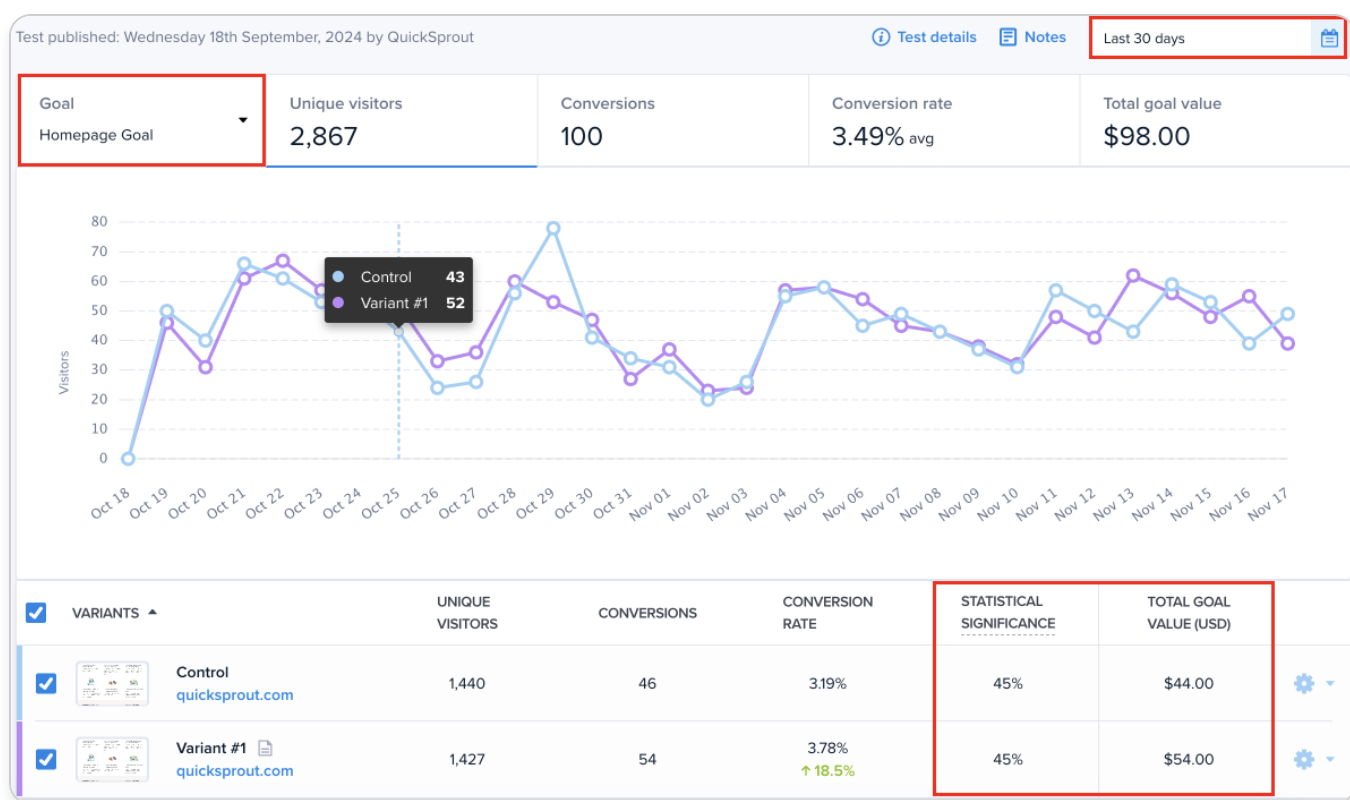If you’re in the market for a Heap alternative, we’ve got you covered with four excellent choices: Crazy Egg, Mixpanel, Pendo, and Fullstory.
We will go through the pros and cons of each, along with who each tool works best for.
My Personal Top 3 Alternatives to Heap
No time to deep-dive into each of the choices right now? This table gives a brief overview of why I picked the top three that I did.
| Best for marketers and designers | Best for product teams | Best for enterprise teams |
|---|---|---|
 |  | |
| Crazy Egg Pricing: Free plan with analytics, $29+/mo for paid plans What I like: Tracks clicks, scrolls, and mouse movement with a simple script. Offers five map types, built-in A/B testing, free analytics and surveys. | Mixpanel Pricing: $24+/mo What I like: Tracks product analytics for apps and websites with real-time reporting, custom events, segmentation, and A/B testing. All tied to user behavior. Also has user funnels. | Pendo Pricing: Enterprise What I like: Has analytics, feedback, and in-app guidance for all channels. Tracks web, mobile, and AI interactions with surveys, heatmaps, and session replay. Lots of feature depth and a large product suite. |
How I Chose These Heap Alternatives
Because Heap offers a suite of web and app analytics tools, from session replays and heatmaps to surveys and AI summaries.
Any good alternative will offer all of this, and then some.
Here are the qualities I prioritized:
- Tracks what users actually do. A good Heap alternative will capture clicks, pageviews, and other actions users perform every day—all without requiring a ton of manual setup.
- Easy to set up. Heap is meant to be an out-of-the-box solution, so an alternative should offer the same type of easy setup. You shouldn’t need to schedule an appointment with a developer every time you want to track a new event type or create a new user segment.
- Clear reporting. Allows you to easily see what’s happening on your site through visual displays like session replays and heatmaps. The more heatmap types, the better.
- Lets you compare users by group. You can sort similar users into groups—like users that all rage-click at a specific spot, or users that tend to visit the pricing page before they exit your site. This makes it easier to spot patterns and decode why specific behaviors happen.
- Helps test your ideas. You can run simple A/B tests or experiments to see if a change you want to make on your site or product—like a different header or banner image— actually improves conversions. (Heap doesn’t actually allow you to do this natively, but it’s integral to creating the best version of a product or site—so I included it.)
- Integrates with key tools. It connects with your data warehouse, other analytics tools (especially Google Analytics 4), email marketing platform, and CRM for smooth work operations.
Each tool I chose below meets these requirements in one way or another.
Let’s begin!
1. Crazy Egg
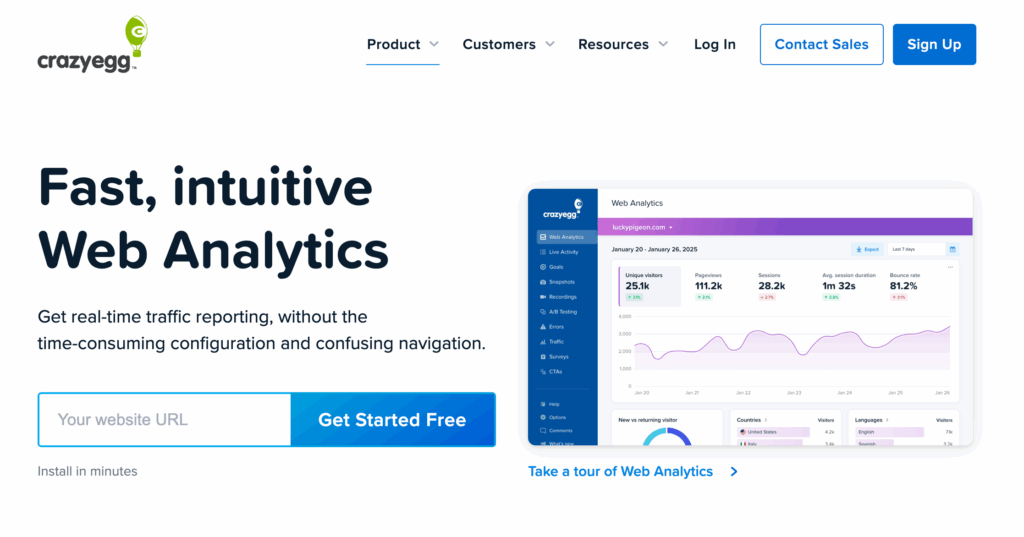
Crazy Egg is a web analytics tool focused on offering visually appealing insights, from heatmaps to session recordings.
What I like:
- Automatic behavior tracking. Crazy Egg will automatically capture all the clicks, scrolls, and mouse movements that matter on your website—no configuration needed. All you have to do to get started is add a small tracking script to your website, and the recording begins. That said, you can configure specific pages or add privacy masking for more control over what’s captured. In my opinion, this is the ideal blend of flexibility and ease of use.
- A free plan that includes web analytics and surveys. If you hate Google Analytics and are looking for a free option that helps you easily see what’s going on with your website (without any of the headaches), Crazy Egg is a perfect option.
- Easy to narrow the scope. If you want to focus on a specific page, you can use Crazy Egg’s Snapshots feature to get a report on only the page you want to study right then. For example, you could generate a Snapshot report on just your pricing, sign-up, or checkout pages. This helps avoid the clutter that can so easily accumulate when you’re gathering website data.
- Highly visual. Crazy Egg offers five map types to help you visualize the way users are interacting with your website: heatmaps, scroll maps, confetti maps, overlays, and list reports. Each map type offers a slightly different—and useful—perspective. Together, you get a detailed picture of what’s making them tick—and what isn’t.
- Group-level insights. The confetti maps are especially useful if you want to segment behaviors by different characteristics. In a confetti map, the user’s actions are broken down by attributes like device, traffic source, new vs. returning visitors, or ad campaign. This makes it easy for you to compare and contrast how each user group behaves—and in a highly visual way.
- Built-in A/B testing. You can test your web copy, color or branding changes, or layout tweaks all within the same tool. This means you can validate your ideas first before you commit to a complete redesign or change in your website’s code.
- Native survey tool. As a Heap alternative, Crazy Egg goes above and beyond with its free, built-in survey tool. (Heap doesn’t offer native surveys.) Crazy Egg’s on-page surveys let you directly ask visitors for feedback from within your website. You can pair this qualitative data with your quantitative metrics for a clear picture of why users do what they do.
- Integrations for every workflow. Crazy Egg connects with Google Analytics 4, HubSpot, Shopify, and WordPress. With its Zapier integration, you can connect to even more tools, from Slack to Mailchimp.
What could use improving:
- No app insights. Crazy Egg is designed for webpage insights, not for in-depth SaaS product analytics. If you need a Heap alternative that does track user behaviors within apps, Mixpanel or Pendo could be the ideal alternatives.
Who should use it:
- Teams that want to improve conversions and the user experience (UX) on marketing or e-commerce sites—especially marketers, store owners, and web designers that want a quick answer to questions like, “Why are users leaving off before they get to my checkout page?!” Crazy Egg pricing begins at $29 a month.
2. Mixpanel
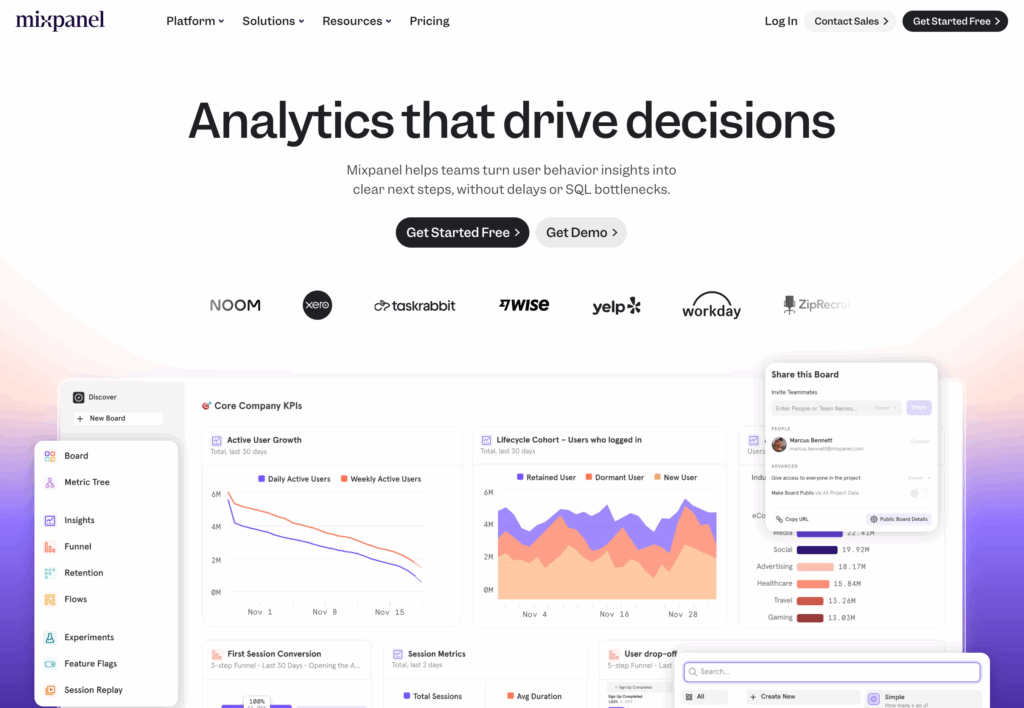
Mixpanel is a product analytics platform built to show you how people use your product over time, from the features that engage them to those that cause them to churn.
What I like:
- Flexible automatic event tracking. Like Crazy Egg, Mixpanel automatically tracks key user actions once you insert the tracking snippet on your site. But you can also easily define custom events for Mixpanel to track. For instance, you can track how much a specific feature gets used. Or which CTA button gets the most attention. This is important for a product analytics tool that tracks apps and websites.
- Real-time reporting. Mixpanel’s live reporting means you can see events as they happen. Teams can build and observe funnels in real-time and watch as users either drop off or convert—or a mix of the two. They can then dig into the retention issues underpinning these actions, all without waiting for data to upload. It’s already there.
- Powerful segmentation and cohort analysis. With Mixpanel, teams can group users by their behavior, geographic location, plan type (important for SaaS products!), or other, custom properties. They can then use this information to track how those groups evolve over time. This helps uncover any retention issues or spot the most active users so you can study what keeps them around.
- Experimentation. Mixpanel’s native experimentation and A/B testing tools make it easy for you to compare and test different versions of a web or app feature, message, or layout. You can then analyze how each variant affects conversion, engagement, and retention.
- Strong integrations and exporting capabilities. Mixpanel integrates smoothly with major tools like Segment, HubSpot, Salesforce, Snowflake, BigQuery, and LaunchDarkly. You can also connect to marketing and CRM platforms, plus tools like Slack, for a collaborative experience across your team. With the Zapier integration, many more integrations are available.
What could use improving:
- Setup isn’t exactly straightforward. Setting Mixpanel up initially can take a lot of time, especially if you want super-precise event naming. Your product, engineering, and analytics teams will have to dance carefully together to define consistent event names and properties.
- Reporting can be complicated to understand. If your team isn’t very technical, you may struggle to interpret and use the data you collect from your site or app. While Mixpanel has begun making its offerings more visual with dashboards and templates, it still takes some data literacy to fully understand.
Who should use it:
- Product and growth teams that want detailed visibility into feature usage, retention, and user journeys on SaaS products and apps. Paid pricing for Mixpanel begins at $24 a month.
3. Pendo
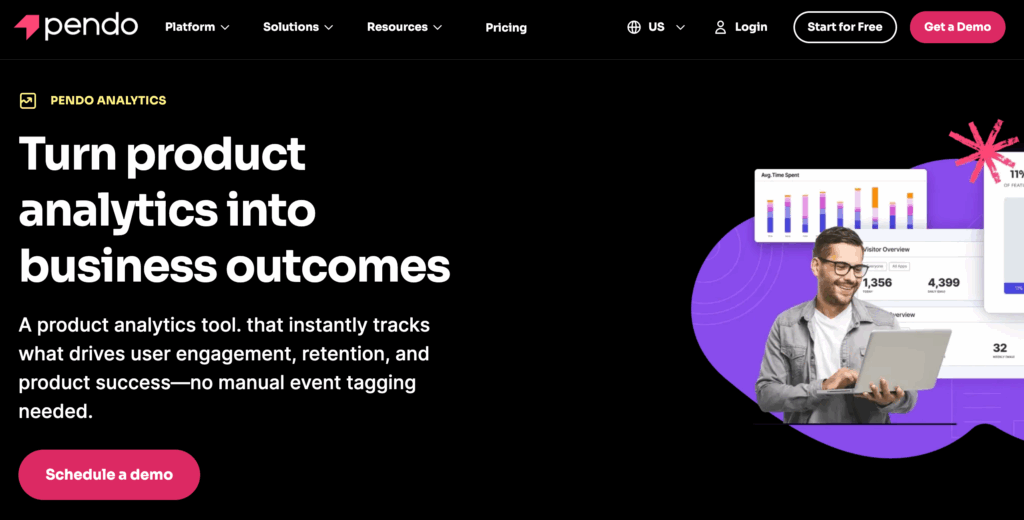
Pendo is a product experience platform that does a bit of everything, from analytics and in-app guides to feedback collection and adoption tools.
What I like:
- Collects analytics across every part of the product experience. Pendo tracks how people use your software at every step, from your website and mobile app to internal tools and even AI interfaces, like AI help agents. From these various areas, it captures page and feature usage, user paths, funnels, retention trends, rage clicks, and dead clicks.
- In-app surveys. With Pendo, you can offer surveys (including net promoter score, or NPS, surveys and results) from right within your website or app interface. This gives you a qualitative, human perspective on why certain features do or don’t convert.
- In-app guides and onboarding. This feature right here is why Pendo landed on my list of the best Heap alternatives. While other tools, like Fullstory and Mixpanel, allow you to collect quantitative data from apps, Pendo goes a step further and gives you an easy way to address issues users may have. Especially if they’re issues that stem from users finding your app a little confusing to navigate. You can create tips, walkthroughs, and announcements that function inside your product. Use them to highlight new features, onboard users, or reduce drop-offs, all without having to download a separate onboarding software.
- Visual tagging for easy setup. You can directly tag buttons, menus, and important UI components through Pendo’s visual interface. In other words, you don’t have to touch code each time you want to track a new feature in Pendo, which makes setup faster and easier to maintain over time.
- Session replay and heatmaps. Pendo now offers session replay and heatmap tools that show exactly where and how users interact with your app. You can visualize where they click, scroll, or get stuck—just like on Crazy Egg, Mixpanel, and Fullstory.
- Integrations. Pendo integrates with all the major players—Jira, Figma, Qualtrics, Zendesk, Hubspot, and Salesforce. Plus Zapier for thousands of other potential connections.
What could use improving:
- More broad than deep. One of the aspects I appreciate about Pendo is also a drawback: it’s very broad, which means it doesn’t go as deep into each feature as it could. Also, the more advanced versions of some key features are locked behind higher-tier, higher-cost plans—well that’s what I assume. While there are various plan tiers published, pricing is unavailable unless you request it.
- High pricing. ‘Nuff said. While Pendo doesn’t publish its pricing, reports on Userpilot quote an average of $47,330 annually. The lowest quoted price is $15,000 a year, so approximately $1,250 a month.
Who should use it:
- Product, growth, and customer success teams that want to understand user behavior and act on it from within the same interface. Pendo is particularly useful for SaaS or enterprise software brands that want to drum up more users and keep them happy with clear-as-water guides. Explore Pendo’s plans here.
4. Fullstory

Fullstory is an analytics platform for improving the digital experience across websites and apps—including employee app interfaces.
What I like:
- Automatically captures data. Fullstory records just about every interaction on your website or app from the jump. This includes clicks, scrolls, form inputs, hover movements, and navigation pathways. You don’t have to tag or define any of these events manually, which is nice.
- Full session replay and heatmap tools. See your users’ behavior in context with session replay or use heatmaps to see which elements are and aren’t used. While most analytics tools only have this for customer-facing apps or websites, I love that Fullstory offers it for your internal apps, too.
- Top-notch friction and error detection. Fullstory automatically tracks and flags rage clicks, dead clicks, errors, and even thrashes—aka, rapid back-and-forth actions/clicks that signal a user has had it with a feature.
- Collaboration is easy. I love that on Fullstory, you and your team can collaborate by commenting on actual sessions, sharing links, and integrating your insights into Slack or Jira. Or, with Zapier, whatever workflow tool you use. This also speaks to the power of Fullstory’s integrations. Like Crazy Egg, Mixpanel, and Pendo, it also integrates with Zapier for (practically) unlimited integration opportunities.
What could use improving:
- Pricing issues. Okay, so the “pricing issues” I’m talking about are that Fullstory is expensive, and that its pricing isn’t transparent. As your traffic scales, so will the cost of Fullstory’s tools. According to Vendr, the median Fullstory buyer pays $27,506 a year. Eek! That’s too steep for many small teams.
- Setup isn’t so quick and simple. While Fullstory auto-captures a lot of what you need, setup can still take a lot of configuration, especially if you want to mask data and manage the scope of your session recordings.
Who should use it:
- Teams that want to see how users across both public- and employee-facing apps interact with their products. See Fullstory’s plans for more information.
What’s the Best Heap Product Alternative?
The best Heap alternative, as far as affordability and feature scope go, is either Crazy Egg or Mixpanel. These tools offer the visual insights, A/B testing, and session recordings you need to gather meaningful insights.
Mixpanel offers app analytics where Crazy Egg doesn’t, though. At the same time, Crazy Egg offers a free survey feature that Mixpanel does not.
If you’re an enterprise business that wants to make sure everything users interact with runs smoothly, Pendo is for you. For more insights into employee-facing apps, go with Fullstory.
See our list of more web analytics tools to consider, or explore how Heap compares to Google Analytics.



